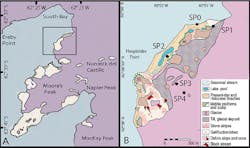Flow cytometry, microscopy, and spectroradiometry map microbes in Antarctic snowmelt
Snowmelt on the Antarctic Peninsula has been increasing for decades, due to rising temperatures, and it shows no signs of stopping. Despite the potential importance of microbes residing in Antarctic snow, few studies have investigated their role in melting. New research by Hodson et al. addresses this gap in knowledge by illuminating the activity and influence of microbes inhabiting wet snow on Livingston Island, located off the tip of the Antarctic Peninsula.
RELATED ARTICLE: Flow cytometry pushes the envelope of applications possibilities
During austral summer in 2013 and 2014, the research team collected snow samples at five different sites in the island's Hurd Peninsula region. Three sites were less than 100 m from the shoreline, one site was 500 m inland, and the fifth site was 750 m inland. The scientists investigated the chemical, physical, and biological characteristics of the snowpack at each site.
To assess the snow algal population, they used microscopy, laser counting techniques (flow cytometry), and spectroradiometry, finding that red-pigmented algae were dominant at the snow surface, while green algae were present below. Bacterial cells are too small for detailed characterization in this way, so the team focused on the cells' ribosomal RNA (16S rRNA). Although microbes have evolved over millions of years, rRNA genes have changed very little. Measuring slight changes in this easily sequenced gene therefore gives clues to how closely microbes in a given population are related, and allows researchers to establish the bacterial community structure.
Genetic sequencing of 16S rRNA genes in the snow samples revealed that microbial communities closer to the coast consisted of a greater diversity of bacterial species than did the inland glacial snowpacks. Inland communities consisted mostly of typical snow bacteria, while coastal communities also had species associated with soil and the ocean.
The scientists also found evidence that algae growing on the surface of the snowpacks can accelerate melting. This is because some algae produce pigments that darken the snow and increase absorption of solar radiation. Such algae were much more plentiful near the coast than inland, likely thanks to fertilization with calcium from rock debris and with ammonium from the droppings of penguins and seals.
Dissolved organic carbon can serve as a food source for other microbes and for marine life, so these findings indicate that Antarctic snow-dwelling microbes can indeed influence nutrients in meltwater. The authors propose that the effects of microbial activity on downstream nutrients be taken into account when considering the full impact of warming on the Antarctic Peninsula.
SOURCE:Journal of Geophysical Research – Biogeosciences; Journal Highlights; http://agupubs.onlinelibrary.wiley.com/hub/article/10.1002/2016JG003694/editor-highlight/

Gail Overton | Senior Editor (2004-2020)
Gail has more than 30 years of engineering, marketing, product management, and editorial experience in the photonics and optical communications industry. Before joining the staff at Laser Focus World in 2004, she held many product management and product marketing roles in the fiber-optics industry, most notably at Hughes (El Segundo, CA), GTE Labs (Waltham, MA), Corning (Corning, NY), Photon Kinetics (Beaverton, OR), and Newport Corporation (Irvine, CA). During her marketing career, Gail published articles in WDM Solutions and Sensors magazine and traveled internationally to conduct product and sales training. Gail received her BS degree in physics, with an emphasis in optics, from San Diego State University in San Diego, CA in May 1986.
